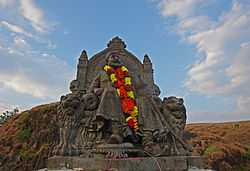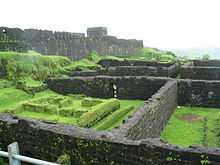Raigad Fort
| Raigad Fort | |
|---|---|
|
Raigad District, Maharashtra (near Mahad) | |
|
Raigad fort towers | |
 Raigad Fort Shown within Maharashtra | |
| Coordinates | 18°14′01″N 73°26′26″E / 18.2335°N 73.4406°E |
| Type | Hill fort |
| Height | 1,356 metres (4,400 ft) ASL |
| Site information | |
| Owner | Government of India |
| Controlled by |
Bijapur
|
| Open to the public | Yes |
| Site history | |
| Built by | Hiroji Indulkar (Deshmukh) |
| Materials | Stone, Lead |
| Garrison information | |
| Past commanders | Shivaji Killa |
| Occupants | Sambhaji |
Raigad is a hill fort situated in the Mahad, Raigad district of Maharashtra, India. The Maratha king Shivaji made the fort his capital in 1674 when he was crowned King of a Maratha Kingdom which later developed into the Maratha Empire eventually covering majority of modern day India.[1][2]
The fort, which rises 820 metres (2,700 ft) above sea level, is located in the Sahyadri mountain range. There are approximately 1737 steps leading to the fort, though today an areal tram exists to reach the top of the fort. The fort was looted and destroyed by the British upon.
History
[[File:The Ghats from Raigad.jpg|thumb|left|The Ghats from Raigad]]
Shivaji Maharaj had seized the fort in 1656, then the fortress of Rairi, from the royal house of the Chandrarrao Mores, a junior or Cadet dynasty to descended from the ancient Maurya imperial dynasty. The last More king (or raja) was a feudatory of the Sultan of Bijapur. Shivaji renovated and expanded the fortress of Rairi and renamed it Raigad (the King's Fort). It became the capital of Shivaji's kingdom.
In 1765 the Raigad Fort, along with Malwan in present Sindhudurg District, the southernmost district of Maharashtra, was the target of an armed expedition by the British East India Company, which considered it a piratical stronghold.
In 1818 the fort was bombarded and destroyed by, using cannons.
Major features
The fort was built by Chandrarao Mores in 1030. Its ruins today consist of the queen's quarters: six chambers, with each chamber having its own private restroom. The main palace was constructed using wood, of which only the bases of pillars remain. Ruins of three watch towers can be seen directly in front of the palace grounds overlooking an artificial lake called Ganga Sagar Lake created next to the fort. It also has a view of the execution point called Takmak Tok, a cliff from which the sentenced prisoners were thrown to their death. The area is now fenced off.[3] The fort also has ruins of the market, and it has such structure that one can shop even while riding on a horse.
The fort has a famous wall called "Hirakani Buruj" constructed over a huge cliff. Its story is that a woman by the name of Hirakani from a nearby village at the foothills of Raigad had come to sell milk to the people living in the fort. She was inside the fort when the gates were locked by sunset. The love for her infant son back at her village gave her the courage to climb down the cliff in the dark. She repeated the feat in front of King Shivaji, and was rewarded for it. In appreciation of her courage, Shivaji arranged for a wall built at this location. Even today we can see it standing.
The king's public Durbar has a replica of the original throne that faces the main doorway called the Nagarkhana Darwaja. This enclosure had been acoustically designed to aid hearing from the doorway to the throne. A secondary entrance, called the Mena Darwaja, was supposedly the private entrance of the royal ladies of the fort; it leads to the queen's quarters. The erstwhile main entrance to the fort is the imposing Maha Darwaja. The convoy of the king and the king himself used the Palkhi Darwaja. To the right of Palkhi Darwaja, is a row of three dark and deep chambers. Historians believe that these were the granaries for the fort.[4]
A statue of Shivaji maharaj is erected in front of the ruins of the main market avenue that eventually leads to the Jagdishwar Mandir and his own Samadhi (tomb) and that of his dog Waghya. The statue was removed by alleged members of the Sambhaji Brigade[5] in July 2012 as a protest but was re-instated by Shri Shivaji Raigad Smarak Samiti, the Archaeological Survey of India, sculptor Rambhau Parkhi and the District Administration[6]
Gallery
-

Statue of Shivaji Maharaj at Raigad fort
-
Map of Raigad
-
Information of Raigad Fort in Marathi Language
-
The step of Hiroji Indalkar(Deshmukh). He constructed the fort
-

"Pratipat Chandra lekhev...."
-

Raigad Fort and Takmak tok (end) on the left)
-

Bajarpeth and Nagarkhana
-
Main Door shape of Raigad fort
-
Statue of Shivaji Maharaj at the spot where his rajyabhishek took place.
-
Ropes of Raigad Ropeway.JPG
-

Ruins of the old palace at Raigad fort
-
The Ganga Sagar Lake, main water reservoir for the fort
-

-

-

Nagarkhana Darwaja
-

-

-

-

Shivaji Maharaja's Samadhii
-

-

-

-
-

-

-
.jpg)
References
- ↑ "Raigarh Fort". Retrieved 2012-05-18.
- ↑ "Raigarh". Imperial Gazetteer of India, Volume 21. 1909. pp. 47–48. Retrieved 2014-02-19.
- ↑ Gunaji, Milind (2005). Offbeat Tracks in Maharashtra. Popular Prakashan. p. 41. ISBN 81-7154-669-2. Retrieved 2009-03-17.
- ↑ Write-up from the Raigad ropeway
- ↑ "73 held for removing Shivaji's dog's statue from Raigad fort". DNA. Retrieved 4 August 2012.
- ↑ "Vaghyacha putala punha basavala". Sakal. Retrieved 4 August 2012.
External links
| Wikimedia Commons has media related to Raigad Fort. |
- http://www.amazingmaharashtra.com/2012/08/raigad.html
- Raigad Fort Trek
- Raigad Fort Pictures
- Raigad Fort Photos & Information (Travel Guide)
- (Raigad Fort Place to See)
| ||||||||||||||||||||||||||||||||||||||||||||||||||||||||||||||||||||||||||
| ||||||||||||||||||||||||||||||||||||||||||||||||||||||||||||||||||||||||||||||||||
| ||||||||||||||||||||||||||||||||||







